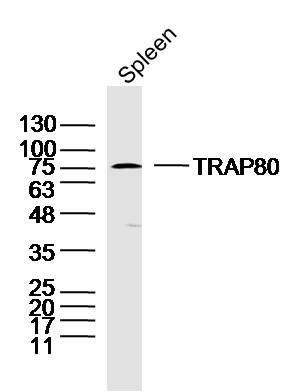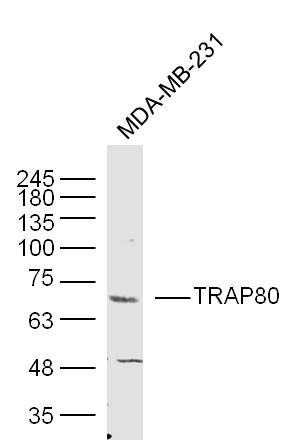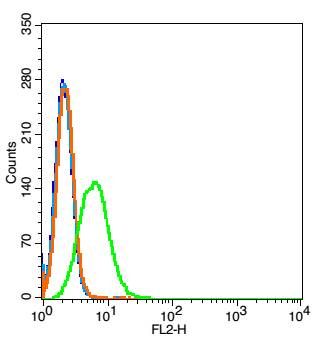In mammalian cells, transcription is regulated in part by high molecular weight coactivating complexes that mediate signals between transcriptional activators and RNA polymerase (1). These complexes include CRSP (for cofactor required for Sp1 activation), which is required, in conjunction with TAFIIs, for transcriptional activation by Sp1 (2). CRSP is ubiquitously expressed in various tissues and functions as a multimeric complex that consists of nine distinct subunits (3). Several members of the CRSP family share sequence similarity with multiple components of the yeast transcriptional mediator proteins, including CRSP150, which is related to yeast Rgr1, and CRSP70, which is similar to the elongation factor TFIIS (4). CRSP77 and CRSP150 are also related to proteins within the putative murine mediator complex, while CRSP130 and CRSP34 are largely unrelated to either murine or yeast proteins (2,5). CRSP subunits also associate with larger multimeric coactivaor complexes, including ARC/DRI, which binds directly to SREBP and nuclear hormone receptors to facilitate transcription, and with NAT, a polymerase II-interacting complex that represses activated transcription (6,7).
Function:
Component of the Mediator complex, a coactivator involved in the regulated transcription of nearly all RNA polymerase II-dependent genes. Mediator functions as a bridge to convey information from gene-specific regulatory proteins to the basal RNA polymerase II transcription machinery. Mediator is recruited to promoters by direct interactions with regulatory proteins and serves as a scaffold for the assembly of a functional preinitiation complex with RNA polymerase II and the general transcription factors.
Subunit:
Interacts with GATA1 and PPARG. Component of the Mediator complex, which is composed of MED1, MED4, MED6, MED7, MED8, MED9, MED10, MED11, MED12, MED13, MED13L, MED14, MED15, MED16, MED17, MED18, MED19, MED20, MED21, MED22, MED23, MED24, MED25, MED26, MED27, MED29, MED30, MED31, CCNC, CDK8 and CDC2L6/CDK11. The MED12, MED13, CCNC and CDK8 subunits form a distinct module termed the CDK8 module. Mediator containing the CDK8 module is less active than Mediator lacking this module in supporting transcriptional activation. Individual preparations of the Mediator complex lacking one or more distinct subunits have been variously termed ARC, CRSP, DRIP, PC2, SMCC and TRAP. Interacts with STAT2.
Subcellular Location:
Nucleus.
Tissue Specificity:
Ubiquitous.
Post-translational modifications:
Phosphorylated upon DNA damage, probably by ATM or ATR.
DISEASE:
Defects in MED17 are the cause of microcephaly postnatal progressive with seizures and brain atrophy (MCPHSBA) [MIM:613668]. It is a disorder characterized by postnatal progressive microcephaly and severe developmental retardation associated with cerebral and cerebellar atrophy. Infants manifest swallowing difficulties leading to failure to thrive, jitteriness, poor visual fixation, truncal arching, seizures. There is no acquisition of developmental milestones and patients suffer from marked spasticity and profound retardation. Progressive microcephaly becomes evident few months after birth.
Similarity:
Belongs to the Mediator complex subunit 17 family.
SWISS:
Q9NVC6
Gene ID:
988
Database links:
Entrez Gene: 988 Human
Entrez Gene: 234959 Mouse
Omim: 603810 Human
SwissProt: Q9NVC6 Human
SwissProt: Q8VCD5 Mouse
Unigene: 444931 Human
Unigene: 44151 Mouse
| Picture |
Sample:
spleen(mouse) Lysate at 40 ug
Primary: Anti-TRAP80 (SL11437R) at 1/300 dilution
Secondary: IRDye800CW Goat Anti-Rabbit IgG at 1/20000 dilution
Predicted band size: 73kD
Observed band size: 75 kD
Sample: MDA-MB-231 Cell (Human) Lysate at 40 ug
Primary: Anti-TRAP80 (SL11437R) at 1/300 dilution
Secondary: IRDye800CW Goat Anti-Rabbit IgG at 1/20000 dilution
Predicted band size: 73 kD
Observed band size: 73 kD
Blank control (blue line): Hela(fixed with pre-warmed 4% paraformaldehyde for 30min at 37℃ and then permeabilized with 90% ice-cold methanol for 30 min on ice)
Primary Antibody (green line): Rabbit Anti-TRAP80 antibody (SL11437R),ilution: 0.2μg /10^6 cells;
Isotype Control Antibody (orange line): Rabbit IgG .
Secondary Antibody (white blue line): Goat anti-rabbit IgG-PE,Dilution: 1μg /test.
|
|
|


